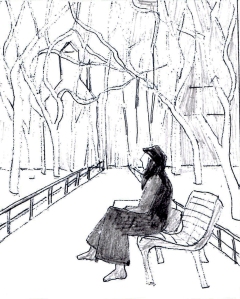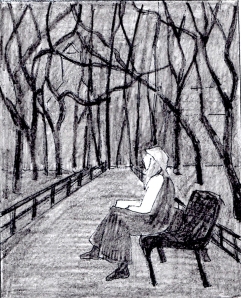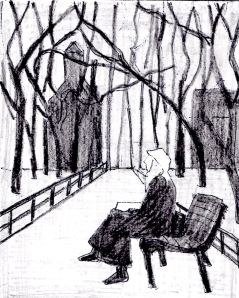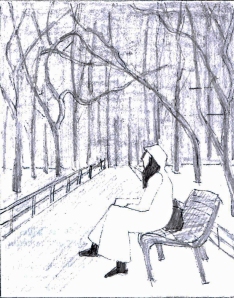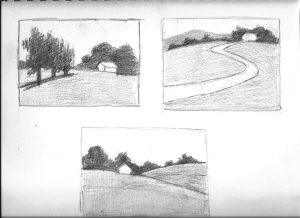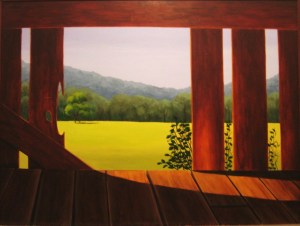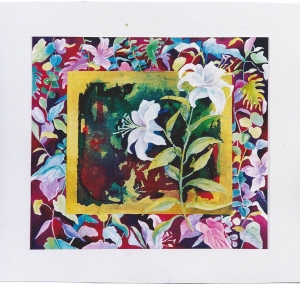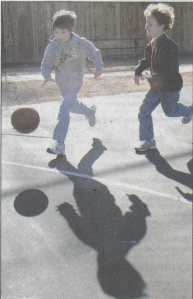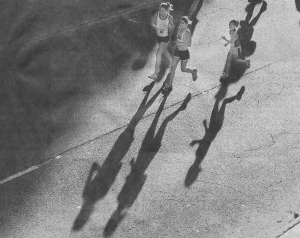Photo journalists seem to like finding subjects with strong cast shadows — you can find lots of these in your local newspapers from time to time. Select a few of these and make corresponding formats (margins) in your sketchbook. Then draw only the shadows as your subject matter. Can you tell what time of day it is by observing the length of the shadows? From which direction is the light source? This is a good way to concentrate on shape only to the exclusion of anything else.
Monthly Archives: December 2013
Paint or draw a domestic ritual
If you are looking for a new idea for a drawing or a painting, think about using a domestic ritual as the subject. Consider the whole area and make a composition – the ritual could be in the foreground, middle, or background. A lot of subjects come to mind: fixing your hair in the morning, meditating, eating a meal, fixing dinner, taking kids to the park — anything that has become an accustomed part of your day. My morning ritual is to read the morning paper while drinking a cup of coffee and eating one of those frozen, microwaveable egg, bacon, cheese, and biscuit sandwich. I look forward to this ritual every day.
I have not painted this scene as yet, but it’s an idea to hold in the back of my brain — my problem is that I have too much stuff in that brain as it is!
SIX PATTERN SCHEMES
This suggestion is from Edgar A. Whitney’s book on watercolor. He writes that there are six value pattern schemes to be considered in planning a composition, and one should choose the best pattern for his/her subject. So I took a photograph and reduced it to the simplest shapes, and did a value sketch of it in each one of Whitney’s schemes. The result is shown below. I suggest that you try this before starting any new composition.
I never did the painting of this scene in one of the value schemes. Maybe I should do it — please tell me which value pattern you think would work the best for the subject?
1. Small darker value in lighter values
2. Small lighter value in darker values
3. Small light area and large dark area in midtones
4. small dark area and large light area in midtones
5. Gradations in any direction
6. All over pattern
SOME BASIC RULES OF SHAPE
When I teach drawing techniques, I always stress these rules. I received this advice from several sources, and it helped me make better drawings and paintings. It works not only for still life, but landscapes and figures as well, so I’m passing it on to you:
1. If the large shape is right, the painting will be right, so think in terms of the largest shape first and draw it, then go to the smaller shapes within.
2. Look for enrichment shapes, including highlights, shadows, reflections, patterns, and textures.
3. Tie the shapes together — this may be by overlapping or cast shadows, or by similar values/colors adjacent to each other.
4. When you see negative shapes, draw them. Negative shapes often help us correctly draw the positive ones. The negative shapes are the spaces around the positive shapes. (More on this later.)
5. The sequence of drawing objects: the shape is first, then the form (placing values to make a 3-dimensional illusion), then the object (the details that make the viewer understand what is being drawn.
If you keep these rules in mind, you will greatly simplify your task of representational depiction.
MAKE DECISIONS WITH THUMBNAIL SKETCHES
When starting a landscape, especially if in plein air, it is a good idea to pre-plan with some compositional sketches. Even though these are called “thumbnail sketches,” they’re really quite larger than a thumbnail. These sketches are about 3 x 5″ in size. I made three of them on the same sheet of sketchbook paper before deciding how to proceed. You want to ask yourself these questions: 1. Do I want a horizontal or a vertical format; 2. Do I want to show more foreground (high horizon line), or more sky area (low horizon line); 3. How can I reduce the scene to 5 shapes or less? To simply and concentrate on large shapes only, pull all the areas that are close in value into one shape, omit the details, and shade your sketch with only 4 values — light, medium light, medium, and dark or medium dark. You may have to squint your eyes or take off your glasses to do this! Doing these steps forces you to look at the subject as a simplified pattern of light and dark shapes. After all, the large shapes in a painting are what make a GOOD PAINTING! I chose the second sketch from above to use as my subject for a pastel painting.
FRAME WITHIN A FRAME
Here is another idea for a different composition. Using a square format, make a frame within a frame such as above. Draw or paint your main subject on top of the interior frame, but extend it outward into the outer frame. Then using the same motif, make designs and patterns all around the exterior frame. This painting is named “From Suffering, Endurance” and is in watermedia.

